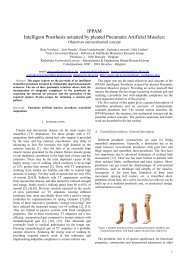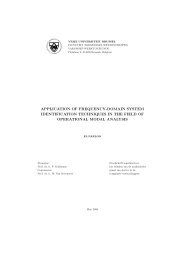VRIJE UNIVERSITEIT BRUSSEL Acoustics - the Dept. of ...
VRIJE UNIVERSITEIT BRUSSEL Acoustics - the Dept. of ...
VRIJE UNIVERSITEIT BRUSSEL Acoustics - the Dept. of ...
Create successful ePaper yourself
Turn your PDF publications into a flip-book with our unique Google optimized e-Paper software.
100 CHAPTER 6. NOISE CONTROLFigure 6.1: Heating system. The boiler is an active noise component and <strong>the</strong>radiators radiate <strong>the</strong> noise (<strong>the</strong>y’re passive noise components).In order to consider noise control, determining <strong>the</strong> source <strong>of</strong> <strong>the</strong> noise, is<strong>the</strong> first thing to do. Depending on <strong>the</strong> nature <strong>of</strong> this source, <strong>the</strong>re are anumber <strong>of</strong> possible ways <strong>of</strong> transmission <strong>of</strong> noise and radiation <strong>of</strong> noise, asindicated in Figure 6.2.For each machine, following procedure has to be used :1. Divide <strong>the</strong> machine in active and passive noise components.2. For each component, determine whe<strong>the</strong>r structure-, hydrodynamic- oraerodynamic noise is generated.3. Locate <strong>the</strong> transmission paths and determine whe<strong>the</strong>r structural, hydrodynamicor aerodynamic noise is transmitted.4. Identify <strong>the</strong> radiating surfaces.5. Identify <strong>the</strong> primary contributions (sources, transmission paths andradiating surfaces).As an example, consider <strong>the</strong> hydraulic group in Figure 6.3. The activenoise components are : <strong>the</strong> electrical motor, <strong>the</strong> hydraulic pump and a valve.The hydraulic group has sources generating structure-borne, hydrodynamic
















